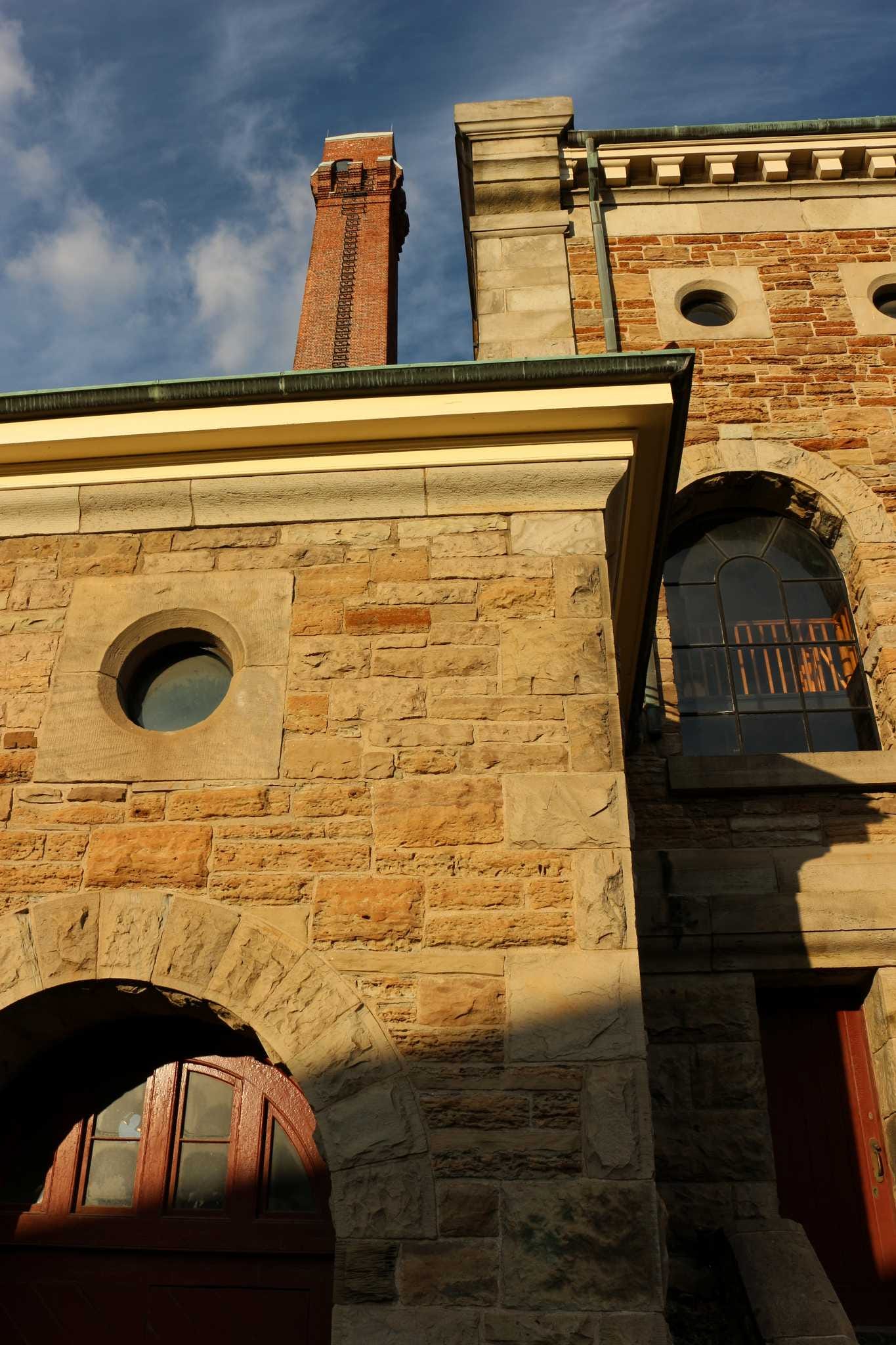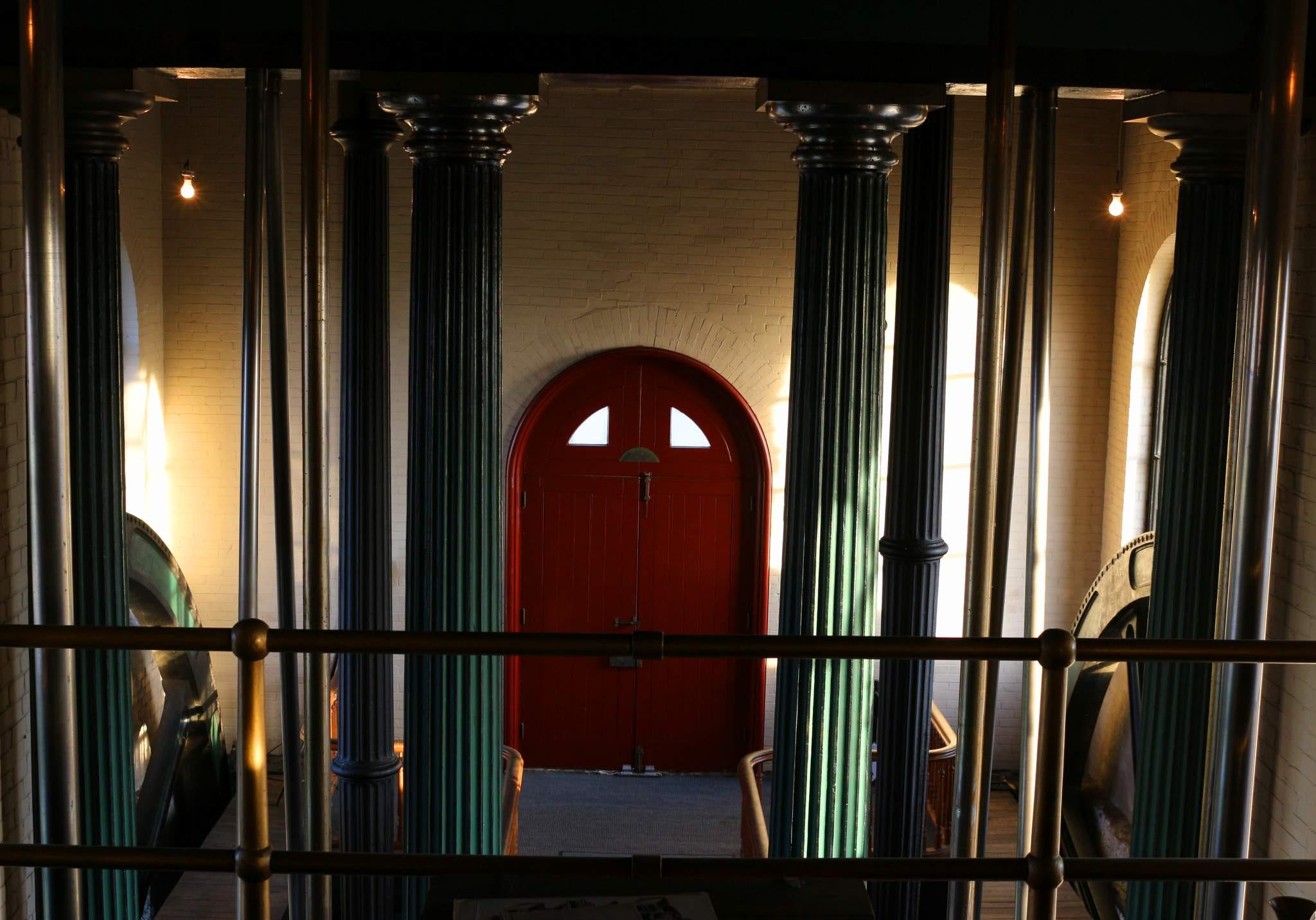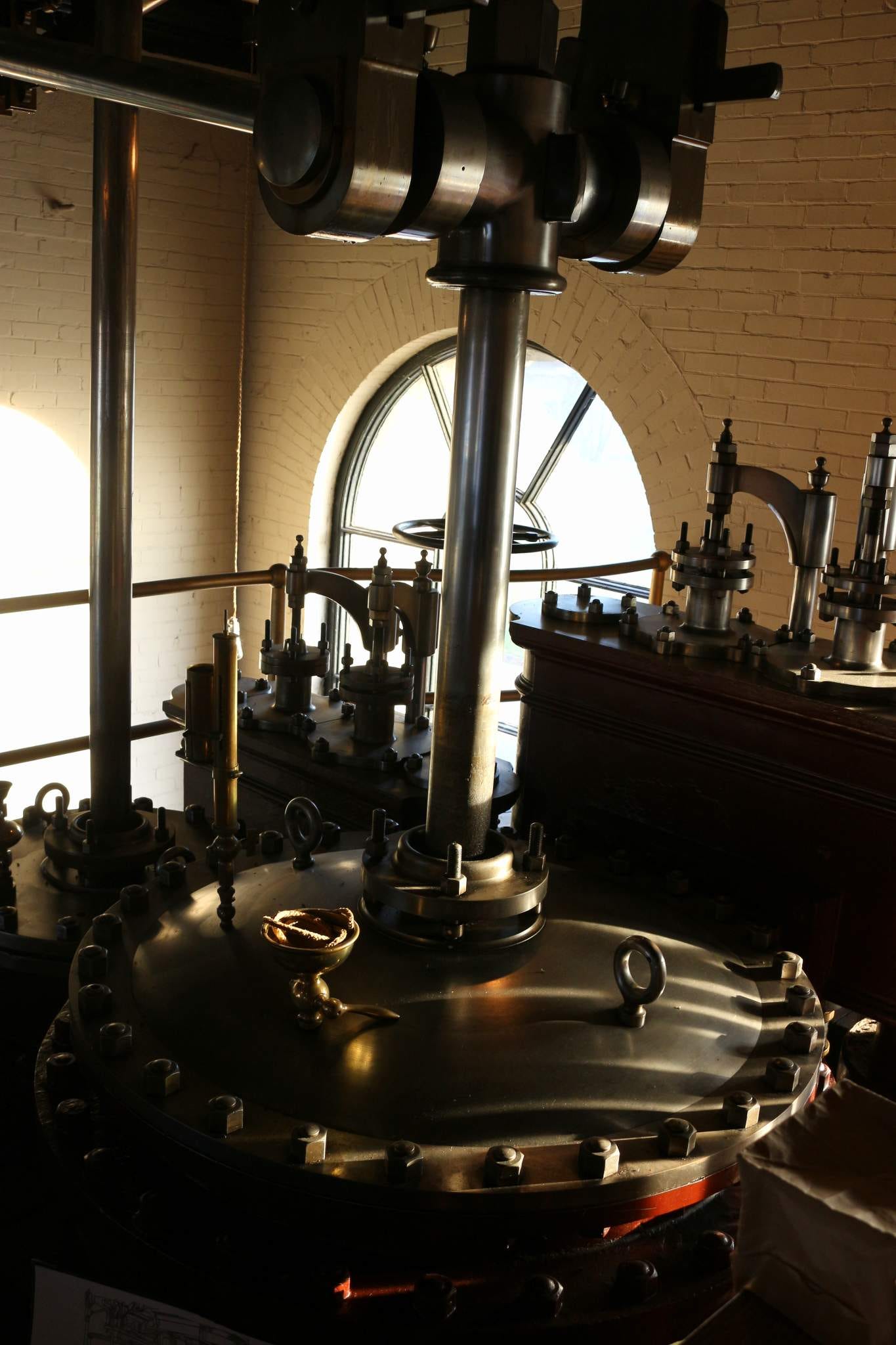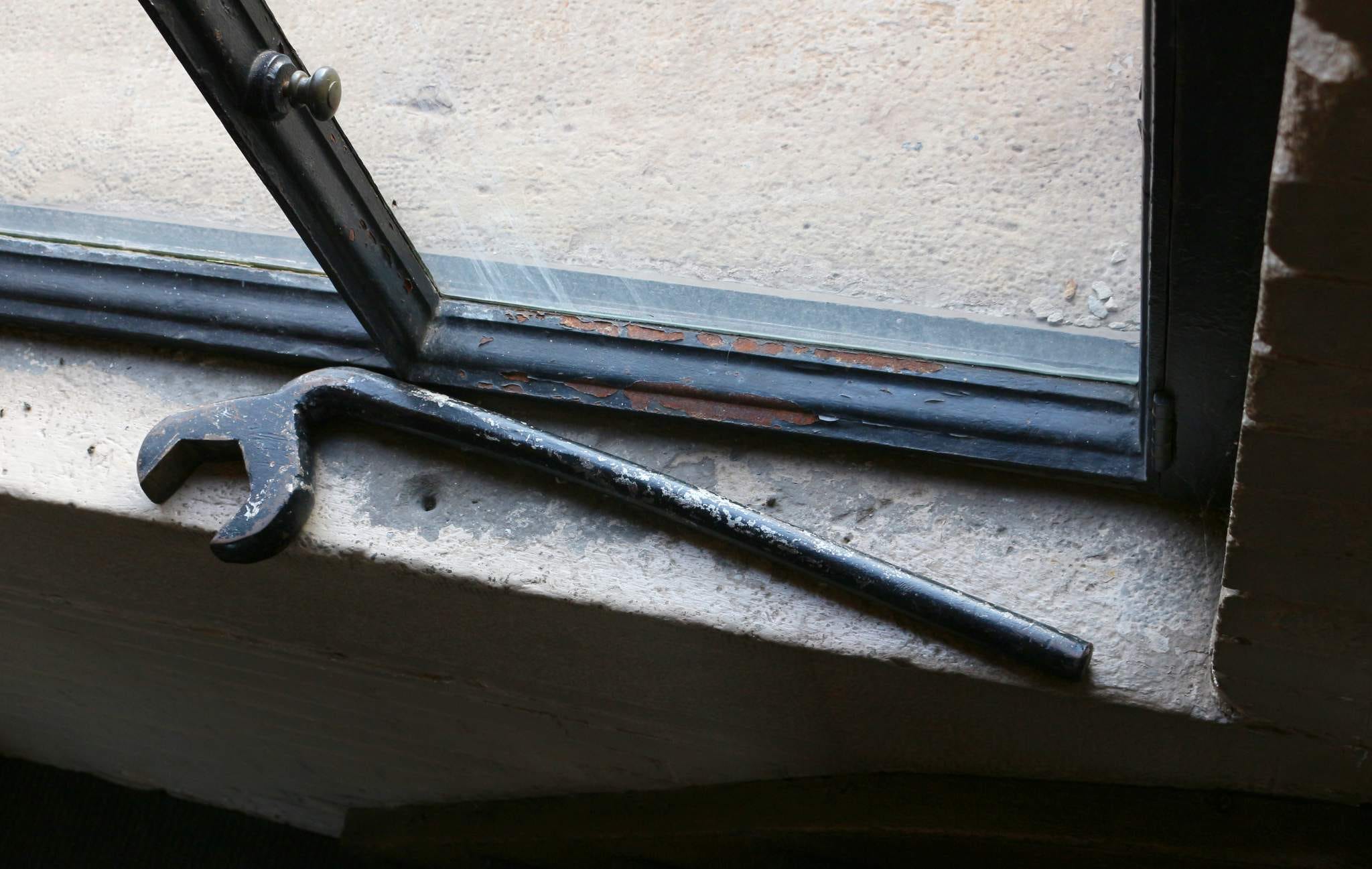Hamilton steam
As I mentioned the other day (Pinhead-camera) Catherine and I had a lovely day-trip with her father Neville to see the Hamilton steam museum last week. The museum consists of five structures which went into operation in 1860 - and the exquisite machine-house contains two seventy-ton beam engines - the oldest in Canada in their original location. Our tour guide Julia was knowledgeable and enthusiastic - genuine keeners recognize one another instantly (her ears perked-up when I mentioned Newcomen, which in turn, told me that she didn't just like the site - but steam power in a much broader sense as well). She gave us a great tour, and also had a ton of additional insight, to answer even our wacky questions.
No flue-flaw fleeing (top photo)
For example, about that fearsome ladder-climb on the outside of the smokestack! Yes, the keen observer (with good zoom and eyes) will note there is a channel in each of the rungs, through which was strung a chain to work the flue - BUT - this is Canada, folks - so it wasn't uncommon to have to send someone climbing up there in the middle of winter with a crowbar, to lever open the frozen-flue! And if that doesn't sound like a scary-enough climb - the chimneysweep job was even more taxing. Just imagine climbing up to the top of that ladder with a rucksack full of heavy stones, and then dropping them down the sides, to knock the big-pieces of accumulated detritus to the bottom, where they can be shovelled away before causing serious problems (no brush long-enough!).
Manifest literature
When I first studied to be a technician, I realized that individual components are very much like letters - particular circuits like words - and the clever assembly of whole families of these into working apparatus, very like the accumulation of human knowledge reflected in all literature. The history remains present, even in the most modern applications (I used to work on $4,000 CD players with a magnetic-levitation 'sled' for the laser, but they still used a screw-drive for the loading mechanism - crossbow-tech!).
This wonder struck me very much the same - and indeed, though an electronic tech by trade, my specialty was 'transports' which is to say, the mechanical side of that - levers and cams and gears, oh my! Because I started in the eighties, and finished in the new millennium, I saw the last few generations of moving-parts entertainment tech, turntables, VCRs, and every kind of analog and digital tape machine. Some were so miniaturized that I needed a jewellers loupe, just to check the screw-pitch! But the solutions I saw before me, always referred back to the work of people decades and centuries before - building on it, and fully expecting to be built-upon in turn.
Columns and flywheels
This was true then - it was true all through my career and remains true now - if you're going to make something, you might as well make it beautiful and lasting - this shows respect for the materials involved, the end-user, and the workers involved in production and operation. Aesthetics are for every-day especially.
As a man very big on flywheels (and curious about precession) the whole idea of those twin 24-foot cast-iron flywheels running at 14 RPM struck me as wonderful! I'd love to know what sort of gyroscopic forces are exerted on the building, especially as they are building or discharging momentum!
Right in the middle of it
Ordinarily, they operate the mechanism using electric motors to show visitors how they work, but these were temporarily out of service when we were there.
Not a problem! This just meant that standing in the middle of what would have been dangerous powerful gnashing machinery to get a nice shot was entirely risk-free and peaceful. (Would have gone for it anyhow) ;o)
The business-end
Here's the upper-level, where the operators had to sweat and dance, staying ever vigilant, despite fast-moving heavy equipment heaving constantly around them.
Must have been stifling in the summer - but the engines could not be oiled only at the start and end of day, they needed constant infusions of fresh lubricant to do their heavy-duty (water-pumping) service - hence the dancing back and forth, avoiding hazards, while still darting-in to feed each of the oil-cups on the steaming behemoth regularly, lest the machinery seize or wear unduly.
Serious safety equipment
Well yeah, that is a paper-hat, but they weren't kidding about it being needed. We sometimes laugh at obsolete design solutions - but consider the conditions of the operators. Super-hot mechanism, constant oil-feeding, and absolute necessity for measured movement (to avoid being snagged and/or mangled).
One drop of hot oil from above, hitting your scalp and startling-you, or running down into your eyes without any warning - and you're in big trouble! So yes, these really were the regulation safety hats for the workers up here - also notably spiffy pieces of Victorian Origami, as such things go. (Kraft paper, not dinner!) ;o)
Thor's spanner
This original tool is now being used to hold-closed a window - a clue to its mass, right off - but I am a testosterone-being, so I just had to give it a heft.
Naturally, grabbing-it at the far end like a hammer, gave it a full measure of leverage working against me - but all the same - there's not a chance I could usefully lift that tool, let alone work with the thing all day long - and you should see the custom cast-iron pry-bars they had, so that they could personally jump-start those massive multi-ton flywheels! They sure made 'em tough, back then!
Tiny train
We had a great visit, and we were already interested in coming back again for one of the many events they hold (hopefully a talk by the author of 'Unbuilt Toronto' and 'Unbuilt Hamilton' soon - fascinating books).
But then I peeked out the window and caught the summer-attraction they set up behind the museum - one of those cute tiny trains that you can ride-on! SOLD! Yes folks - a wonderful museum, a nice head full of history and mechanical inspiration - and come spring, choo-choos! Full-marks indeed. Firing, as they say, on all cylinders!
¯\_(ツ)_/¯










